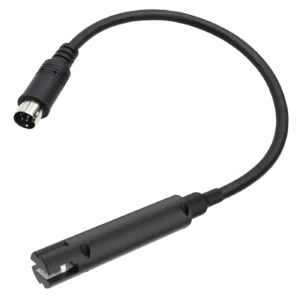
About this article
This article will provide you with troubleshooting tips specifically for the IOND sensor. If you still require assistance, please use the ticket system so we can provide further support.
Read this before you get started
The ION Director is a high-precision measuring instrument for the automatic determination of various ions in water.
The innovative measuring method uses minimal potential changes on ion-selective membranes in the µV range to determine ion concentrations.
The sensitive procedure requires extremely careful installation and that the latest version of the IOND and IOND sensor instructions are followed exactly.
It must also be ensured that all devices (such as ProfiLux, Doser, IOND) always have the latest firmware.
All manuals and firmware (included in latest GHL Control Center version) can be downloaded from the GHL download page: https://www.aquariumcomputer.com/downloads/
Installation errors will result in poor or no measurement results and faster sensor wear. A bad sensor performance ( = too low sensor voltages) is not necessarily caused by a bad sensor, but air in the system, dirty filter or insufficient pumping can also be the cause, so bad sensor performance is not the cause but the consequence of other problems.
IOND sensors are wearing parts and have to be replaced regularly, but before replacing the sensor it should first be checked whether one of the causes of the error listed below is present and must be corrected if necessary.
Sensor Troubleshooting
The most common causes of errors and their correction measures are explained below:
| Error / Problem | Impact / Explanation | Solution |
| Flex PVC tube is not used in all mandatory places: The complete path for the sample water as well as for the references A and B must be made of Flex-PVC, before as well as after the dosing pumps. | With other tubes, e.g., silicone, too much air diffuses into the tube, the resulting air bubbles interfere with the measurement and can even affect the service life of the sensor. | Replace all tubes with Flex PVC tubes at the specified locations. |
| Use of tubes that are too long on the inlet sides of the IOND. | The longer the tubing, the greater the likelihood that air will collect, especially with longer pauses between measurements. | Keep tubes as short as possible for best results. |
| Sensor screw connection not tightened sufficiently or assembled incorrectly. | Air passes the sensor and enters the measuring cell, this air disturbs the measurement and can even affect the service life of the sensor. | Check sensor screw connection for correct assembly: Rubber seal - pressure ring - pressing screw. Check rubber for damage and tighten the screw connection sufficiently. If necessary, coat the sensor shaft with Vaseline to improve the seal to the rubber. |
| Sensor is installed incorrectly, the slot in the sensor tip must be aligned vertically, the sensor must be pushed in completely. | If not oriented correctly or not inserted deep enough, correct measurements are not possible. | Install sensor correctly. |
| Air (bubbles) or contaminants are aspirated at the point where the sample is drawn. | Air or impurities interfere with the measurement and can even affect the service life of the sensor. | Select another location to draw the sample. |
| Pumps are poorly calibrated. | If too less reference or sample liquid is pumped, the voltages are too low or the voltage ratios are incorrect, which affects the measuring accuracy. | Recalibrate pumps, check calibration. |
| Error / Problem | Impact / Explanation | Solution |
| Pumps slip or stall and do not run smooth. | If too little reference or sample liquid is pumped, the voltages are too low or the voltage ratios are incorrect, which affects the measuring accuracy. | Clean the inside of the pump, if necessary replace pump wear parts with the maintenance set. Recalibrate pumps, check calibration. |
| Filter is dirty or clogged. | Causes 2 problems: Too small sample quantity affects the measurement accuracy. Biofilm influences the measurement results, especially of NO3. | Replace filter. |
| Use of dirty tubes. | A biofilm influences the measurement results, especially of NO3. | Replace tubes. |
| Devices have outdated firmware. | The measurement cycle is constantly being improved and adapted to the latest sensor technology, so it is essential to always use the latest firmware. | Update firmware to the latest version. |
| Use of incorrect containers for references. | To prevent concentrations from changing due to evaporation or to prevent contamination of the ref. by ambient air or precipitation, suitable closed containers must be used. | Use the original GHL containers together with the supplied lids with holes for tubing and pressure compensation. Bottles must always be closed with these lids. |
| References are too warm or cold. | For optimal measurement, the temperatures of the references should deviate max. 5C (9° F) from the aquarium temperature, otherwise inaccurate measurement results are possible. | Place references near the aquarium, e.g. base cabinet, near technical basin. |
| Error / Problem | Impact / Explanation | Solution |
| Precipitates are present in references. | E.g., too cold storage can lead to precipitation, this leads to bad measuring results. | Remove precipitates: Shake references, if necessary heat slightly during this process. |
| Other contamination in references. | Changes in the concentrations in the references or foreign substances affect the measurement results. | Replace references with fresh ones. |
| Measurements are carried out too infrequently. | The longer the IOND is inactive, the greater the probability that air bubbles will collect and affect the measurement. | For optimum measurement results, measure at least 1x per day, but not more than every 3 days. In case of prolonged inactivity, prime the measuring cell before taking a measurement. |
| IOND is too close to sources of interference. | Strong electromagnetic radiation from (switching) power supplies, ballasts, motors, etc., and their supply lines, can interfere with the sensor signals. | Establish spatial distance to sources of interference, place IOND accordingly. |
| Power supply to IOND is interrupted. | IOND resp. the sensor needs approx. 30 minutes after system start (booting) until all voltages have stabilized. An earlier measurement can lead to errors. | Keep IOND permanently connected to the power supply, do not switch off the power supply. |
| The sensor is overaged and/or has been stored poorly (must be protected from light and high humidity). | Leads to poor voltages or measurement results. | Replace sensor. |
Using the “Test Sensor” function
If all previous error causes can be excluded with certainty, the sensor (or the entire system) can be tested with the “Test sensor” function. Here only a shortened and simplified procedure is carried out, it is only measured at A and B and then all sensor voltages are determined. This function saves time and reference liquid. Since no sample water is pumped and measured, a meaningful sensor voltage can also be determined if there is a problem with the sampling (filter, associated pump, sampling point, etc.).
